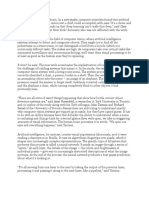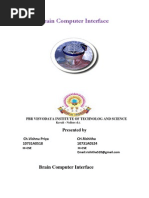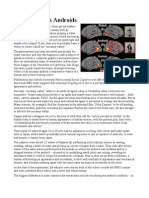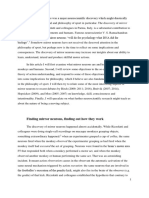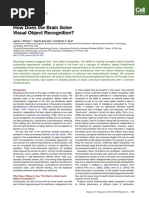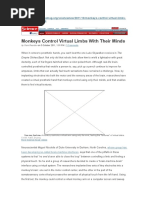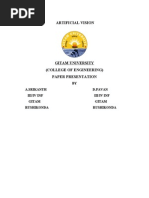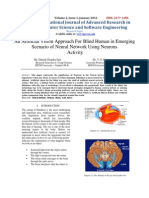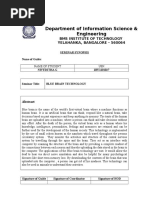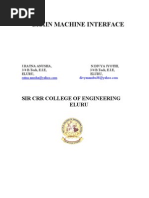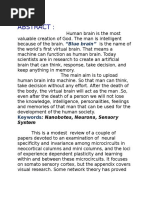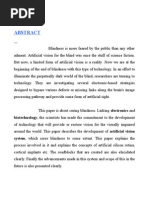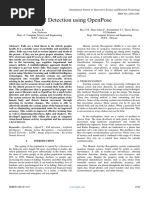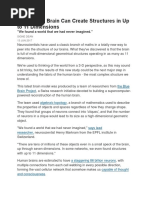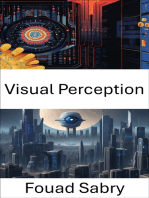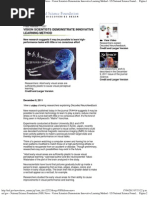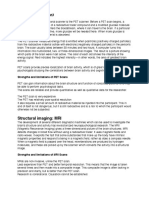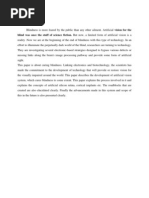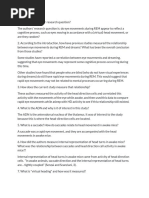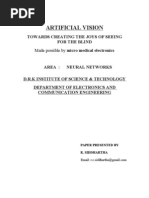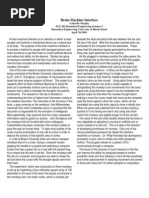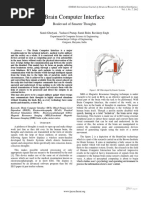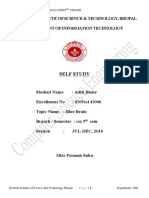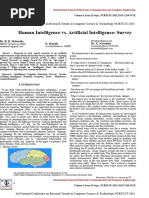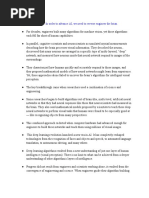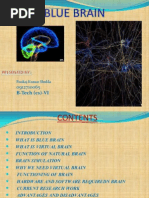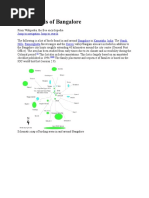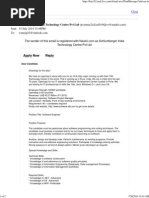0 ratings0% found this document useful (0 votes)
16 viewsVision Robots Article
Vision Robots Article
Uploaded by
Vamsi ReddyIISC scientists have found that neurons in the visual cortex of the brain dynamically process visual information over time to distinguish relevant from irrelevant variations in images. During the initial processing, neurons are sensitive to changes in viewpoint, but later ignore irrelevant stimuli. This transition allows the brain to recognize objects from different angles or perspectives. The researchers recorded neuronal activity in the monkey inferior temporal cortex, crucial for visual recognition. Their findings help explain how the brain achieves viewpoint invariance and suggest that computer vision algorithms have not achieved the human level of visual competence needed for real-world tasks.
Copyright:
© All Rights Reserved
Available Formats
Download as PDF, TXT or read online from Scribd
Vision Robots Article
Vision Robots Article
Uploaded by
Vamsi Reddy0 ratings0% found this document useful (0 votes)
16 views1 pageIISC scientists have found that neurons in the visual cortex of the brain dynamically process visual information over time to distinguish relevant from irrelevant variations in images. During the initial processing, neurons are sensitive to changes in viewpoint, but later ignore irrelevant stimuli. This transition allows the brain to recognize objects from different angles or perspectives. The researchers recorded neuronal activity in the monkey inferior temporal cortex, crucial for visual recognition. Their findings help explain how the brain achieves viewpoint invariance and suggest that computer vision algorithms have not achieved the human level of visual competence needed for real-world tasks.
Original Description:
Robots
Copyright
© © All Rights Reserved
Available Formats
PDF, TXT or read online from Scribd
Share this document
Did you find this document useful?
Is this content inappropriate?
IISC scientists have found that neurons in the visual cortex of the brain dynamically process visual information over time to distinguish relevant from irrelevant variations in images. During the initial processing, neurons are sensitive to changes in viewpoint, but later ignore irrelevant stimuli. This transition allows the brain to recognize objects from different angles or perspectives. The researchers recorded neuronal activity in the monkey inferior temporal cortex, crucial for visual recognition. Their findings help explain how the brain achieves viewpoint invariance and suggest that computer vision algorithms have not achieved the human level of visual competence needed for real-world tasks.
Copyright:
© All Rights Reserved
Available Formats
Download as PDF, TXT or read online from Scribd
Download as pdf or txt
0 ratings0% found this document useful (0 votes)
16 views1 pageVision Robots Article
Vision Robots Article
Uploaded by
Vamsi ReddyIISC scientists have found that neurons in the visual cortex of the brain dynamically process visual information over time to distinguish relevant from irrelevant variations in images. During the initial processing, neurons are sensitive to changes in viewpoint, but later ignore irrelevant stimuli. This transition allows the brain to recognize objects from different angles or perspectives. The researchers recorded neuronal activity in the monkey inferior temporal cortex, crucial for visual recognition. Their findings help explain how the brain achieves viewpoint invariance and suggest that computer vision algorithms have not achieved the human level of visual competence needed for real-world tasks.
Copyright:
© All Rights Reserved
Available Formats
Download as PDF, TXT or read online from Scribd
Download as pdf or txt
You are on page 1of 1
1 of 1
http://epaperbeta.timesofindia.com/Article.aspx?eid=31806&articlexml=...
The Times of India
Title : IISC RESEARCH - Why robots can't beat us in vision
Author :
Location :
Bengaluru:
Article Date : 02/03/2015
Will intelligent robots replace humans some day? A team of scientists from Indian Institute of Science,
Bengaluru, believes it won't happen anytime soon.
This is because even the best computer algorithms can't do simple visual tasks like recognizing distorted
letters. It is a known fact that the eye works much like a camera with neurons leaving the retina carrying
information about the image to visual areas in the brain. Now, IISc scientists have thrown more light on what
makes our brain so good in its vision mechanism.
Dr SP Arun and his team, studying biological vision at the Centre for Neuroscience, IISc, ventured to find
how the vision mechanism in humans sifts between relevant and irrelevant information from the various
images that fall on the retina. One object can produce different images due to changes in lighting, size,
position and three-dimensional rotations. Neurons in the visual cortex compute this. Flashing an image
results in neural activity that builds up and drops over a period of time. During the build-up of the response,
neurons are sensitive to irrelevant variations such as changes in the view point of an object. But during the
drop, neurons ignore irrelevant stimuli, said Arun.
Ratan Murty, another member of the team, said, This transition has never been shown before, and our study
shows that neurons in this area perform this important computation dynamically over time, he added.
The team performed recordings from the inferior temporal cortex of the monkey brain -an area crucial for
visual object recognition.Neurons leaving the retina carry information about the image to the visual areas in
the brain, which occupy as much as 40% of the total real estate in the brain.
Our experiments will help understand viewpoint invariance better, something that the brain has learned to
solve over the course of evolution. Robots may beat us at algorithmic games like chess but they are nowhere
near human competence in real-world tasks like vision, added Arun.
2/4/2015 12:16 AM
You might also like
- Mind-Reading Devices Are Revealing The Brain'S Secrets: FeatureDocument3 pagesMind-Reading Devices Are Revealing The Brain'S Secrets: Featurekhamsa.dreamNo ratings yet
- Design Structure Matrix Methods and Applications - The MIT PressDocument2 pagesDesign Structure Matrix Methods and Applications - The MIT PressVamsi Reddy33% (3)
- A New Study Gary MarcusDocument3 pagesA New Study Gary MarcusParth Hemant PurandareNo ratings yet
- Monkey Brains Feel Virtual Objects.Document3 pagesMonkey Brains Feel Virtual Objects.Anonymous uhv8xRNo ratings yet
- Review Paper On Blue Brain TechnologyDocument8 pagesReview Paper On Blue Brain TechnologyIJRASETPublicationsNo ratings yet
- Reading The Brain From The Outside - Headache1Document6 pagesReading The Brain From The Outside - Headache1shoaibNo ratings yet
- Brain Computer InterfaceDocument8 pagesBrain Computer Interfaceparamesh0098No ratings yet
- Article BIPDocument3 pagesArticle BIPSotya RenaningwibiNo ratings yet
- Artificial Neural Nets Grow Brainlike Navigation Cells 20180509Document4 pagesArtificial Neural Nets Grow Brainlike Navigation Cells 20180509KagzNo ratings yet
- Law and Emerging Technology PsdaDocument10 pagesLaw and Emerging Technology PsdaManan GuptaNo ratings yet
- Vlab Manual Ch07Document10 pagesVlab Manual Ch07daniellestfuNo ratings yet
- Mirror NeuronsssDocument26 pagesMirror NeuronsssChloe BujuoirNo ratings yet
- A Seminar Report On Brain Computer InterfaceDocument16 pagesA Seminar Report On Brain Computer InterfaceAnit SachdevaNo ratings yet
- Action Observation and Acquired Motor Skills: An fMRI Study With Expert DancersDocument7 pagesAction Observation and Acquired Motor Skills: An fMRI Study With Expert DancersvxnNo ratings yet
- Blue Brain ReportDocument25 pagesBlue Brain ReportMichael SheppardNo ratings yet
- 1 s2.0 S1364661313001691 MainDocument3 pages1 s2.0 S1364661313001691 Mainpfrancesco.soaveNo ratings yet
- Perspective: How Does The Brain Solve Visual Object Recognition?Document20 pagesPerspective: How Does The Brain Solve Visual Object Recognition?Kaito KaleNo ratings yet
- Monkeys Control Virtual Limbs With Their Minds.Document2 pagesMonkeys Control Virtual Limbs With Their Minds.Anonymous uhv8xRNo ratings yet
- Brain Computer InterfaceDocument8 pagesBrain Computer InterfaceswethaharithaNo ratings yet
- Ar VI FoDocument9 pagesAr VI Fobasu33No ratings yet
- Artificial VisionDocument9 pagesArtificial VisionvijayakumarnknNo ratings yet
- Object Detection System With Voice Alert For BlindDocument7 pagesObject Detection System With Voice Alert For BlindIJRASETPublicationsNo ratings yet
- The Research Methods of BiopsychologyDocument2 pagesThe Research Methods of BiopsychologyJanice PilapilNo ratings yet
- V2I1048Document5 pagesV2I1048editor_ijarcsseNo ratings yet
- Visual Mental Imagery: A View From Artificial IntelligenceDocument47 pagesVisual Mental Imagery: A View From Artificial IntelligenceflaviasmansanoNo ratings yet
- Department of Information Science & Engineering: Bms Institute of Technology Yelahanka, Bangalore - 560064Document2 pagesDepartment of Information Science & Engineering: Bms Institute of Technology Yelahanka, Bangalore - 560064Kavitha SANo ratings yet
- Brain Machine InterDocument8 pagesBrain Machine InterAnusha JavvajiNo ratings yet
- Reading material 2 human andmachinesDocument6 pagesReading material 2 human andmachinesDhruv MukherjeeNo ratings yet
- Abstract:: "Blue Brain"Document2 pagesAbstract:: "Blue Brain"umamaheswariNo ratings yet
- Corneal Imaging System Environment From EyesDocument19 pagesCorneal Imaging System Environment From EyesCuerpo IndigenaNo ratings yet
- Eye DocumentationDocument18 pagesEye DocumentationJavaharReddyNo ratings yet
- Blue BrainDocument6 pagesBlue BrainBryan396No ratings yet
- Artificial Vision: M.Sonika P.Srikanth Iv/Iv B.Tech (E.C.E)Document11 pagesArtificial Vision: M.Sonika P.Srikanth Iv/Iv B.Tech (E.C.E)itabassum5No ratings yet
- Fall Detection Using OpenPoseDocument4 pagesFall Detection Using OpenPoseInternational Journal of Innovative Science and Research TechnologyNo ratings yet
- Brain Gate ReportDocument31 pagesBrain Gate ReportRahul Bansal50% (4)
- Real-Time Object Detection Using Deep LearningDocument4 pagesReal-Time Object Detection Using Deep LearningIJRASETPublicationsNo ratings yet
- 3592-Ophthalmologists and Physicists Team Up To Design Bionic EyeDocument4 pages3592-Ophthalmologists and Physicists Team Up To Design Bionic EyeSumeet SethyNo ratings yet
- 001 The Human Brain Can Create Structures in Up To 11 DimensionsDocument3 pages001 The Human Brain Can Create Structures in Up To 11 Dimensionsdan7maxNo ratings yet
- IJCRT2303148Document7 pagesIJCRT2303148Harsh LoharNo ratings yet
- Can We Change The Structure of Our Brain Just by Thinking - Technology NetworksDocument9 pagesCan We Change The Structure of Our Brain Just by Thinking - Technology NetworksAlexandru LupusorNo ratings yet
- NewsclipscriptDocument4 pagesNewsclipscriptapi-245846042No ratings yet
- Blue Brain AbstractDocument4 pagesBlue Brain AbstractNaijuBiju100% (1)
- AI System Self-Organizes To Develop Features of Brains of Complex OrganismsDocument4 pagesAI System Self-Organizes To Develop Features of Brains of Complex OrganismsJohn Lian NerecinaNo ratings yet
- Visual Perception: Insights into Computational Visual ProcessingFrom EverandVisual Perception: Insights into Computational Visual ProcessingNo ratings yet
- Artificial Intelligence Uprising: How To Build A Sci-Fi RobotDocument4 pagesArtificial Intelligence Uprising: How To Build A Sci-Fi RobotInternational Journal of Application or Innovation in Engineering & ManagementNo ratings yet
- Review Paper On Live Eye Gaze Tracking To Control Mouse Pointer MovementDocument5 pagesReview Paper On Live Eye Gaze Tracking To Control Mouse Pointer MovementIJRASETPublicationsNo ratings yet
- Aprendizaje Tipo MatrixDocument3 pagesAprendizaje Tipo Matrixpatricio80080% (1)
- F Reading On BITsDocument2 pagesF Reading On BITsZahra TejaniNo ratings yet
- Blind Was Once The Stuff of Science Fiction. But Now, A Limited Form of Artificial Vision Is ADocument14 pagesBlind Was Once The Stuff of Science Fiction. But Now, A Limited Form of Artificial Vision Is ASateesh KumarNo ratings yet
- Journal Club 7Document3 pagesJournal Club 7Alex EdwinNo ratings yet
- Artificial Vision: Towards Creating The Joys of Seeing For The BlindDocument11 pagesArtificial Vision: Towards Creating The Joys of Seeing For The BlindSrijan YallaNo ratings yet
- Brain MachineDocument1 pageBrain MachinepankkajNo ratings yet
- Blue Brain-The Future TechnologyDocument27 pagesBlue Brain-The Future TechnologyZuber MdNo ratings yet
- Brain Computer InterfaceDocument6 pagesBrain Computer Interfacesingh.deep.raviNo ratings yet
- Self Study: Oriental Institute of Science & Technology, Bhopal Department of Information TechnologyDocument13 pagesSelf Study: Oriental Institute of Science & Technology, Bhopal Department of Information TechnologyAditi BhateNo ratings yet
- Reading Material 2 Human AndmachinesDocument5 pagesReading Material 2 Human AndmachinesKONINIKA BHATTACHARJEE 1950350No ratings yet
- Next Big Thing: Brain Memory InterfaceDocument13 pagesNext Big Thing: Brain Memory InterfaceK Navneeth RaoNo ratings yet
- Supervised Machine Learning for Science: How to stop worrying and love your black boxFrom EverandSupervised Machine Learning for Science: How to stop worrying and love your black boxNo ratings yet
- Brian Prime NotesDocument20 pagesBrian Prime Notesapi-278394702No ratings yet
- B-Tech (CS) - VI: Pankaj Kumar ShuklaDocument33 pagesB-Tech (CS) - VI: Pankaj Kumar ShuklaPankaj ShuklaNo ratings yet
- Brain Mapping and Its Contribution To The Advancement of Neuro TechnologyDocument7 pagesBrain Mapping and Its Contribution To The Advancement of Neuro TechnologySaarvariNo ratings yet
- Kathewar Dog, Is A Breed of Sighthound From India: Saluki Karnataka Maharashtra Telangana MudholDocument1 pageKathewar Dog, Is A Breed of Sighthound From India: Saluki Karnataka Maharashtra Telangana MudholVamsi ReddyNo ratings yet
- Northern India Jammu and Kashmir Himachal Pradesh Gujjar Bakerwal Himachal Pradesh Tibetan Mastiff Indian Pariah DogDocument1 pageNorthern India Jammu and Kashmir Himachal Pradesh Gujjar Bakerwal Himachal Pradesh Tibetan Mastiff Indian Pariah DogVamsi ReddyNo ratings yet
- DG 1Document1 pageDG 1Vamsi ReddyNo ratings yet
- Behaviour and Ecology: Francolin Indian Subcontinent Grey PartridgeDocument2 pagesBehaviour and Ecology: Francolin Indian Subcontinent Grey PartridgeVamsi ReddyNo ratings yet
- Indian PeafowlDocument2 pagesIndian PeafowlVamsi ReddyNo ratings yet
- List of Birds of Bangalore: Jump To Navigation Jump To Search Bangalore Karnataka India Nandi Hills Bannerghatta KaveriDocument2 pagesList of Birds of Bangalore: Jump To Navigation Jump To Search Bangalore Karnataka India Nandi Hills Bannerghatta KaveriVamsi ReddyNo ratings yet
- Breeding: Erlangeri (Zedlitz, 1912) - The Fairly NumerousDocument1 pageBreeding: Erlangeri (Zedlitz, 1912) - The Fairly NumerousVamsi ReddyNo ratings yet
- Current Density in A Round ConductorDocument3 pagesCurrent Density in A Round ConductorVamsi ReddyNo ratings yet
- Rain QuailDocument1 pageRain QuailVamsi ReddyNo ratings yet
- Skineff 2Document2 pagesSkineff 2Vamsi ReddyNo ratings yet
- Cause: Skin Effect Is The Tendency of AnDocument2 pagesCause: Skin Effect Is The Tendency of AnVamsi ReddyNo ratings yet
- Corona Effect: Definition: The Phenomenon of Ionisation of Surrounding Air Around The Conductor Due To WhichDocument1 pageCorona Effect: Definition: The Phenomenon of Ionisation of Surrounding Air Around The Conductor Due To WhichVamsi ReddyNo ratings yet
- OnecoreffectDocument1 pageOnecoreffectVamsi ReddyNo ratings yet
- Contents: Corona EffectDocument1 pageContents: Corona EffectVamsi ReddyNo ratings yet
- Disadvantages of Corona DischargeDocument1 pageDisadvantages of Corona DischargeVamsi ReddyNo ratings yet
- 04.project Billing SystemDocument25 pages04.project Billing SystemHarish BoraNo ratings yet
- KGFDocument3 pagesKGFVamsi ReddyNo ratings yet
- Cars WeightDocument2 pagesCars WeightVamsi ReddyNo ratings yet
- Unblock Your Abundance?: Tuesday, July 22, 2014Document3 pagesUnblock Your Abundance?: Tuesday, July 22, 2014Vamsi ReddyNo ratings yet
- New Features in The New Release? Ans. Django's Latest Official Stable Version Is Django 2.2, It's The LTS Version and Will GetDocument1 pageNew Features in The New Release? Ans. Django's Latest Official Stable Version Is Django 2.2, It's The LTS Version and Will GetVamsi ReddyNo ratings yet
- Java Equivalents in C#Document13 pagesJava Equivalents in C#Vamsi ReddyNo ratings yet
- Schlumberger IndiaDocument2 pagesSchlumberger IndiaVamsi ReddyNo ratings yet
- Bhagavad Gita Best VersesDocument10 pagesBhagavad Gita Best VersesVamsi ReddyNo ratings yet
- 6 Reading MythsDocument3 pages6 Reading MythsVamsi ReddyNo ratings yet


